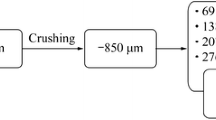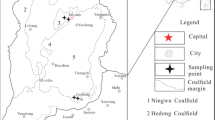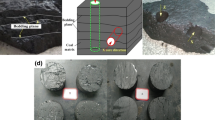Abstract
Coal water slurry gasification is a main source of hydrogen in the developing hydrogen economy. Moreover, biomass and waste can be added, making gasification process greener. To expand the application of coal water slurry and gasification process, it is necessary to understand the micro-structure in this large particle suspension system. In this paper, the micro-structure in coal water slurry was studied by extended DLVO (eDLVO) theory and fractal dimension, which is used to explain the mechanism of stability in large particle suspension systems. The interaction between two coal particles was characterized from the interparticle potential and energy barrier based on the eDLVO theory. The rheology and stability between different types of coals are measured and explained by the aggregating structure and fractal dimension in coal water slurry. The results indicated that there would be an aggregating structure in high rank coals, due to the interparticle potential caused by the surface properties, but probably not in low rank coals. This aggregating structure can be described and characterized by fractal dimension. The aggregation of particles is the source of the stability for high rank coals, as the close-packed 3D network structure in large particle suspension can support coal particles from settling down. The results have demonstrated that the combination of the eDLVO theory and rheological measurement is an effective way to investigate the stability of large particle suspension systems.
Similar content being viewed by others
Abbreviations
- a :
-
Diameter of particle
- A 121 :
-
Hamaker constant of material 1 in medium 2 with material 1
- d p :
-
Distance of glass rod traveled
- d s :
-
Length of the supernatant above the mud line
- d t :
-
Height of the total slurry
- D :
-
Fractal dimension of aggregation structure
- H :
-
Distance between two particles
- k :
-
Boltzmann constant
- K :
-
Consistency coefficient
- K 121 :
-
Hydrophobic constant of material 1 in medium 2 with material 1
- n :
-
Rheological index
- R :
-
Radius of agglomeration structure
- T :
-
Temperature
- V D :
-
Van der Waals force/potential
- V E :
-
Double layer force/potential
- V H :
-
Hydrophobic force/potential
- V T :
-
Total potential energy
- β :
-
Structural coefficient
- ε :
-
Dielectric constant
- θ :
-
Contact angle
- \({\rm{\dot \gamma}}\) :
-
Shear rate
- κ :
-
−1 Debye screening length
- ρ :
-
Material density
- σ :
-
Shear stress
- σ :
-
0 Yield stress
- ϕ :
-
v Volume fraction of particles
- ψ :
-
δ Stern potential
References
Li Q, Zhang J. Coal gasification. In: Cheng Y, Jin Y, eds. Multiphase Reactor Engineering for Clean and Low-Carbon Energy Applications. Wiley, 2017
Strizhak P A, Vershinina K Y. Maximum combustion temperature for coal-water slurry containing petrochemicals. Energy, 2017, 120: 34–46
Papachristodoulou G, Trass O. Coal slurry fuel technology. Canadian Journal of Chemical Engineering, 1987, 65(2): 177–201
Duan Q, Zhang S, Duan J. Development outlook and preparation and application technology of coal water mixture. Coal Science and Technology, 2017, 45: 205–213 (in Chinese)
Wan W, Dai Z, Li C, et al. Innovative concept for gasification for hydrogen based on the heat integration between water gas shift unit and coal-water-slurry gasification unit. International Journal of Hydrogen Energy, 2014, 39(15): 7811–7818
Shim H, Jung S, Wang H Y, et al. The comparison study on the operating condition of gasification power plant with various feedstocks. Korean Journal of Chemical Engineering, 2009, 26(2): 324–331
Zhang Y, Xu Z, Tu Y, et al. Study on properties of coal-sludge-slurry prepared by sludge from coal chemical industry. Powder Technology, 2020, 366: 552–559
Yi S, Hao L, Li S, et al. The influence of water content in rice husk bio-oil on the rheological properties of coal bio-oil slurries. Energy, 2019, 189: 116307
Wang C, Zhao H, Dai Z, et al. The effect of inorganic salt in wastewater on the viscosity of coal water slurry. Environmental Science and Pollution Research International, 2019, 26(14): 14171–14177
Liu P, Zhu M, Zhang Z, et al. Rheological behaviour and stability characteristics of biochar-water slurry fuels: effect of biochar particle size and size distribution. Fuel Processing Technology, 2017, 156: 27–32
Li W, Li W, Liu H, et al. Influence of sewage sludge on the slurry ability of coal-water slurry. Fuel, 2009, 88(11): 2241–2246
Botsaris G D, Glazman Y M. Stability and rheology of coal slurries. In: Botsaris G D, Glazman Y M, eds. Interfacial Phenomena in Coal Technology. New York: Marcel Dekker Inc., 1989
Usui H, Saeki T, Hayashi K, et al. Sedimentation stability and rheology of coal water slurries. Coal Preparation, 1997, 18(3–4): 201–214
Dinçer H, Boylu F, Sirkeci A A, et al. The effect of chemicals on the viscosity and stability of coal water slurries. International Journal of Mineral Processing, 2003, 70(1–4): 41–51
Laskowski J. Coal Flotation and Fine Coal Utilization. Houston: Gulf Professional Publishing, 2001
Li Q, Yang D, Liu Q, et al. Hydrothermal dewatering of lignite water slurries: part 2 surface properties and stability. Canadian Journal of Chemical Engineering, 2019, 97(1): 133–139
Derjaguin B V, Churaev N V, Muller V M. The Derjaguin-Landau-Verwey-Overbeek (DLVO) theory of stability of lyophobic colloids. In: Surface Forces. Springer, 1987
Chaturvedi T, Schembre J M, Kovscek A R. Spontaneous imbibition and wettability characteristics of Powder River Basin coal. International Journal of Coal Geology, 2009, 77(1–2): 34–42
Laskowski J, Kitchener J A. The hydrophilic—hydrophobic transition on silica. Journal of Colloid and Interface Science, 1969, 29(4): 670–679
Israelachvili J, Pashley R. The hydrophobic interaction is long range, decaying exponentially with distance. Nature, 1982, 300 (5890): 341–342
Yotsumoto H, Yoon R H. Application of extended DLVO theory: I. stability of rutile suspensions. Journal of Colloid and Interface Science, 1993, 157(2): 426–433
Yotsumoto H, Yoon R H. Application of extended DLVO theory: II. stability of silica suspensions. Journal of Colloid and Interface Science, 1993, 157(2): 434–441
Boinovich L. DLVO forces in thin liquid films beyond the conventional DLVO theory. Current Opinion in Colloid & Interface Science, 2010, 15(5): 297–302
Yu Y, Ma L, Xu H, et al. DLVO theoretical analyses between montmorillonite and fine coal under different pH and divalent cations. Powder Technology, 2018, 330: 147–151
Wang C, Harbottle D, Liu Q, et al. Current state of fine mineral tailings treatment: a critical review on theory and practice. Minerals Engineering, 2014, 58: 113–131
Deng M, Xu Z, Liu Q. Impact of gypsum supersaturated process water on the interactions between silica and zinc sulphide minerals. Minerals Engineering, 2014, 55: 172–180
Tao D. Role of bubble size in flotation of coarse and fine particles—a review. Separation Science and Technology, 2005, 39 (4): 741–760
Zhang M, Liu Q, Liu J. Extended DLVO theory applied to coal slime-water suspensions. Journal of Central South University, 2012, 19(12): 3558–3563
Piñeres J, Barraza J. Energy barrier of aggregates coal particle-bubble through the extended DLVO theory. International Journal of Mineral Processing, 2011, 100(1–2): 14–20
Yoon R, Mao L. Application of extended DLVO theory, IV: derivation of flotation rate equation from first principles. Journal of Colloid and Interface Science, 1996, 181(2): 613–626
Kaji R, Muranaka Y, Miyadera H, et al. Effect of electrolyte on the rheological properties of coal-water mixtures. AIChE Journal, 1987, 33(1): 11–18
Roh N S, Shin D H, Kim D C, et al. Rheological behaviour of coal-water mixtures. 1. Effects of coal type, loading and particle size. Fuel, 1995, 74(8): 1220–1225
Mewis J, Wagner N J. Colloidal Suspension Rheology. Cambridge: Cambridge University Press, 2012
Ofori P, Nguyen A V, Firth B, et al. Shear-induced floc structure changes for enhanced dewatering of coal preparation plant tailings. Chemical Engineering Journal, 2011, 172(2–3): 914–923
Bushell G C, Yan Y D, Woodfield D, et al. On techniques for the measurement of the mass fractal dimension of aggregates. Advances in Colloid and Interface Science, 2002, 95(1): 1–50
Liao J Y H, Selomulya C, Bushell G, et al. On different approaches to estimate the mass fractal dimension of coal aggregates. Particle & Particle Systems Characterization, 2005, 22(5): 299–309
Bushell G C, Yan Y D, Woodfield D, et al. On techniques for the measurement of the mass fractal dimension of aggregates. Advances in Colloid and Interface Science, 2002, 95(1): 1–50
He Y B, Laskowski J S. Contact angle measurements on discs compressed from fine coal. Coal Preparation, 1992, 10(1–4): 19–36
Qiu X, Zhou M, Yang D, et al. Evaluation of sulphonated acetone-formaldehyde (SAF) used in coal water slurries prepared from different coals. Fuel, 2007, 86(10–11): 1439–1445
Georgakopoulos A. Study of low rank Greek coals using FTIR spectroscopy. Energy Sources, 2003, 25(10): 995–1005
Yoon R, Flinn D H, Rabinovich Y I. Hydrophobic interactions between dissimilar surfaces. Journal of Colloid and Interface Science, 1997, 185(2): 363–370
Pazhianur R, Yoon R. Model for the origin of hydrophobic force. Mining, Metallurgy & Exploration, 2003, 20(4): 178–184
Xu Z, Yoon R H. The role of hydrophobia interactions in coagulation. Journal of Colloid and Interface Science, 1989, 132 (2): 532–541
Israelachvili J N. Chapter 13-van der Waals forces between particles and surfaces. In: Intermolecular & Surface Forces. Academic Press, 2011, 253–289
Quemada D, Berli C. Energy of interaction in colloids and its implications in rheological modeling. Advances in Colloid and Interface Science, 2002, 98(1): 51–85
Soni G. Development and validation of a simulator based on a first-principle flotation model. Dissertation for the Doctoral Degree. Blacksburg, US: Virginia Polytechnic Institute and State University, 2013
Biletskyy V, Sergeyev P, Krut O. Fundamentals of highly loaded coal-water slurries. In: Mining of Mineral Deposits. Boca Raton: CRC Press, 2013
Dzuy N Q, Boger D V. Yield stress measurement for concentrated suspensions. Journal of Rheology (New York, N.Y.), 1983, 27(4): 321–349
Herschel W H, Bulkley R. Measurement of rubber-benzole solutions. Colloid & Polymer Science, 1926, 39: 291–300 (in German)
Mishra S K, Senapati P K, Panda D. Rheological behavior of coal-water slurry. Energy Sources, 2002, 24(2): 159–167
Swain P, Panda D. Rheqlogy of coal-water mixtures. Fuel Science & Technology International, 1996, 14: 1237–1251
Dorget M. Rheological properties of silica-silicone compounds. Dissertation for the Doctoral Degree. Grenoble, France: Institute National Polytechnique, 1995 (in French)
Pignon F, Piau J, Magnin A. Structure and pertinent length scale of a discotic clay gel. Physical Review Letters, 1996, 76(25): 4857–4860
Pignon F, Magnin A, Piau J, et al. Yield stress thixotropic clay suspension: investigations of structure by light, neutron, and X-ray scattering. Physical Review. E, 1997, 56(3): 3281–3289
Piau J M, Dorget M, Palierne J F, et al. Shear elasticity and yield stress of silica-silicone physical gels: fractal approach. Journal of Rheology (New York, N.Y.), 1999, 43(2): 305–314
Author information
Authors and Affiliations
Corresponding author
Rights and permissions
About this article
Cite this article
Li, Q., Wang, Q., Hou, J. et al. Aggregating structure in coal water slurry studied by eDLVO theory and fractal dimension. Front. Energy 17, 306–316 (2023). https://doi.org/10.1007/s11708-021-0736-1
Received:
Accepted:
Published:
Issue Date:
DOI: https://doi.org/10.1007/s11708-021-0736-1




